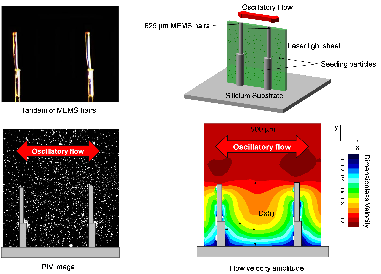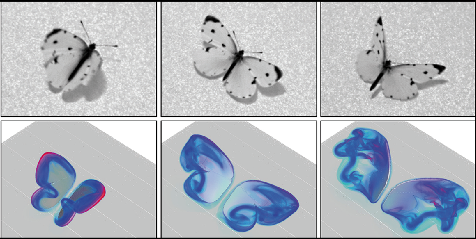

Key references in this research topic:

Because the insect air-
Sparse energy consumption for human transportation is an economic and ecological necessity, due to fuel costs and unwanted pollution. Small changes in the way a wing or plate moves have tremendous impacts on several aspects of the shed vortices and energy consumption. Engineers are therefore keen to learn from insects how a flapping wing really works. In collaboration with physicists and engineers specialised in aeronautics, we tackled this problem only very recently.
What is the question and the organisms studied?

What did we found so far?
Analytical and computational models showed that it is necessary to take into account the mass of air around a single hair! That shows how unintuitive the small scale physics of the insect life can be. We are visualizing the flow around single MEMS sensors and the canopy effects with many sensors (Figure 1). At such small scale, hairs are aerodynamically coupled up to very large distance, up to 50 times their diameters.
Using simple analytical force models and complex 3D computational models of air flow around flapping wings (Figure 2) and high speed video measurements, we observed that butterflies taking off use their legs in a much larger extend than their mere size and morpgology would indicate. Why? Because the legs are powered by large muscles hidden in the thorax. Is then jumping in the air an explanation for the origin of flight? Functional morphology is a key approach to answer these questions, unfortunately on the verge of extinction as scientific field. A stupid mistake.

What next?
Biomimetics is yet another way to tap into the diversity of life and maybe to return some of our benefits to it. When comparing the performance of crickets hairs versus the latest MEMS, we see that the crickets is still several orders of magnitude better, mainly through its unmatched signal processing capabilities. Surprisingly, the number of studies which quantify the comparison between Nature and biomimetic device is very low: biomimetics is too often happy with glossy prints are great pictures. We need instead engineering concepts such as Figure of Merit and the like.


People involved in this research topic:
Key references in this research topic:
Thomas Steinmann
Bimbard, G., Kolomenskiy,D., Casas, J. and R. Godoy-
Casas, J., Liu, C., & Krijnen, G. (2013). Biomimetic Flow Sensors. Encyclopedia Nanotechnology 2013, 264–276.
Casas J, Steinmann T, and Krijnen G (2010) Why do insects have such a high density
of flow-

Institut de Recherche sur la Biologie de l'Insecte
UMR 7261 Faculté des Sciences et Techniques
Avenue Monge, Parc Grandmont
37200 TOURS (France)




